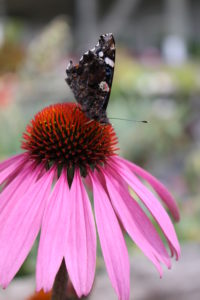Sustainable, Native, Pollinators

Imagine a garden that is not only beautiful and inviting but is also a model of a sustainable eco-system. Native plants, ones that occur naturally in the local surroundings, tend to be better adapted to the local climate and soil conditions and, therefore, are more resistant to diseases and pests than hybrid plants. They are better able to survive in drought conditions once established and thrive in adverse growing conditions. Native plants invite wildlife like native bees, butterflies, hummingbirds, and birds to visit a garden. Native plants don’t need to be manicured; they can be left slightly wild. Native plants tend to be low maintenance while still being pretty.
Why?
- Native gardening is a popular trend for home gardens. It’s a shift in the way we think about our flower gardens.
- Native gardens are a movement towards healing and restoring the land.
- Native plants tend to be water-wise, low maintenance, disease-resistant, drought tolerant once established and thrive in the right conditions.
- Create a sustainable ecosystem above and below the soil.
What are Native Plants?
- Indigenous native plants include woody trees and shrubs, flowering perennials, and grasses. There are native plants for all growing conditions, including sun and shade, dry or moist areas, and all soil types.
What Will the Neighbours Say?
- A native garden can be as formal or informal as you choose to make it.
- Some of my clients worry their native gardens might get complaints from their neighbours for being ‘too wild.’ To keep it tame, select only a few varieties of plants and lay them out in large groups.
- Consider this as an extra incentive to make your native garden the showpiece of the neighbourhood!
Benefits | Environmental
- Native plants tend to be low maintenance once established.
- Leave your leaves. Recycle plant residue with soil composting.
- Reduce chemical & fertilizer use because native plants are less prone to disease & pests and require very little fertilizer.
- Combat climate change by planting native species.
- Reduce carbon pollution by planting long-living native trees.
- Conserve water. Native plants tend to thrive even in summer heat and need less water than hybrid plants.
Benefits | Beauty in a Native Garden
- Many native plants offer beautiful, showy flowers that produce an abundance of exciting & colourful seed heads and fruits.
- Brilliant seasonal colours, from the pale greens in spring to vibrant yellows, oranges, and reds in the fall.
- Amazing winterscapes with interesting stems and branches, textures and colours
- Native plants provide movement and sound in the garden.
- They create a natural backdrop for sitting and watching wildlife!
- Just as important to gardeners are the practical benefits of native gardening: less work and lots of beauty!
- You’ll quickly discover native plants almost look after themselves–after all, that’s what happens in nature.
Benefits | Wildlife
Imagine a songbird flying northwards after a long migratory journey, looking for nourishment and finding acres and acres of manicured lawn. Or a toad looking for a pond in which to breed and finding a sea of asphalt.
- Native plants provide habitat for a wide variety of creatures, such as birds, butterflies & bees, whereas hybrid plants tend to be designed to attract people.
- You can provide a home for native plants as they are becoming increasingly rare in the wild.
- Create a sustainable habitat. Oak Trees provide over 500 species of caterpillars for birds
- Butterflies & moths depend on specific plants for food that you can provide in your native garden
- Provide shelter for flying friends
Flowering Shrubs
Cephalanthus occidentalis, BUTTONBUSH
Cornus alba ‘Sibirica’, RED TWIG DOGWOOD
Diervilla lonicera, LOW BUSH HONEYSUCKLE
Rubus odoratus, FLOWERING RASPBERRY
Symphoricarpos albus, SNOWBERRY
Groundcovers
Arctostaphylos uva-ursi, BEARBERRY
Roses
Rosa blanda, SMOOTH WILD ROSE
Native Grasses
Andropogon gerardii, BIG BLUESTEM
Andropogon scoparius, LITTLE BLUESTEM
Bouteloua gracilis, BLUE GRAMA
Chasmanthium latifolium, NORTHERN SEA OATS
Koeleria cristata, JUNE GRASS
Sorghastrum nutans, INDIAN GRASS
Wildflowers
Achillea millefolium, COMMON YARROW
Agastache scrophulariifolia, PURPLE GIANT HYSSOP
Aquilegia canadensis, COLUMBINE
Aruncus dioicus, GOATSBEARD
Asclepias syriaca, SWAMP MILKWEED
Asclepias tuberosa, BUTTERFLY WEED
Campanula rotundifolia, HAREBELL
Chelone glabra, WHITE TURTLEHEAD
Coreopsis lanceolata, LANCE-LEAFED CORESPSIS
Dalea purpurea, PURPLE CLOVER
Desmodium canadense, SHOWY TICK TREFOIL
Echinacea pallida, PALE PURPLE CONE FLOWER
Epilobium angustifolium, FIREWEED
Eupatorium maculatum, SPOTTED JOE PYE WEED
Geranium maculatum, WILD GERANIUM
Helianthus maximillaini, MAXIMILLAIN’S SUNFLOWER
Heliopsis helianthoides, FALSE SUNFLOWER
Iris versicolor, BLUE FLAG IRIS
Liatris ligulistylus, MEADOW BLAZINGSTAR
Monarda didyma, WILD BEEBALM
Monarda fistulosa, WILD BERGAMOT 6″ pot
Oenothera biennis, Native Yellow EVENING PRIMROSE
Rudbeckia hirta, CONEFLOWER
Rudbeckia triloba, BRANCHED CONEFLOWER
Silphium perfoliatum, CUP PLANT

No Comments
I love how you described gardening with native plants as a model of a sustainable eco-system. There is a reason why people try to regenerate the plant life that has been damaged due to things like deforestation, building construction, or invasive non-native species. Starting with your own garden seems like a good way to join the effort in regenerating the native flowers and grasses. It could be a good influence on your community.
I agree that native plants can be beautiful. I really want to get some native plants for my yard for the beauty benefits. Their color changes is another great reason to get a variety of plants. They will look great during all times of the year.